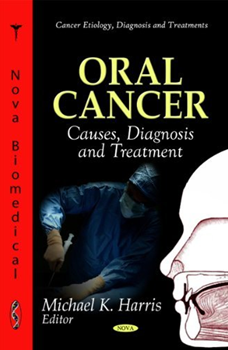 |
Oral Cancer:
Causes, Diagnosis and Treatment |
Editors:Michael K. Harris
Book Description
This new book examines the causes, diagnoses and treatment of oral cancer. Topics discussed include the role of MRI and DCE-MRI in the differential diagnosis of squamous cell carcinomas, salivary gland tumors and malignant lymphoma; radiotherapy for oral cancer; chewing tobacco and oral cancer; tumor suppressor gene detection in oral tumors for new therapeutic strategy; innate immunity and oral carcinogenesis and salivary metabolomics for oral cancer detection. (Imprint: Nova Biomedical Press)
Series:Cancer Etiology, Diagnosis and Treatments
Binding:ebook
Pub. Date:2011 - 4th Quarter
Pages:7x10 (NBC - R) 313pp.
ISBN:978-1-62081-975-3
A Novel Adjuvant Therapeutic Material: Chemoprevention of Monascus-Fermented Product on Oral Cancer; pp. 233-252
(Wei-Hsuan Hsu, Tzu-Ming Pan, Department of Biochemical Science & Technology, College of Life Science, National Taiwan University, Taipei, Taiwan)
Abstract
In recent years, the prevalence of oral tumor has increased exponentially, making it the fifth most common neoplasm and accounting for over 500,000 cases annually. Tobacco and alcohol consumption have been reported as the major factors for the development of oral cancer. Edible fungi of the Monascus species have been used as traditional Chinese medicine in eastern Asia for several centuries. Monascus-fermented rice (red mold rice, RMR) has many functional secondary metabolites, including monacolin K, an inhibitor of 3-hydroxy-3-methylglutaryl coenzyme A reductase in the cholesterol biosynthesis pathway; citrinin; ankaflavin; and monascin. In several recent studies performed in our laboratory, these secondary metabolic compounds have been shown anti-inflammatory, anti-oxidative, and anti-tumor activities. Monacolin K and ankaflavin exert anti-metastasis and anti-angiogenesis effects in lung carcinoma cells via reducing serum vascular endothelial growth factor (VEGF) levels. Furthermore, the ethanol extract of Monascus-fermented rice has been shown to have the inhibitory activity in matrix metalloproteinase (MMP)-7 and reduce tumor growth in the human colon adenocarcinoma SW620 cell line. On the other hand, the ethanol extract of RMR (RMRE) was first applied as a therapy against 7,12-dimethyl-1,2-benz[a]anthracene (DMBA)- induced carcinogenesis in the hamster animal model, in which reduced tumor formation in the hamster buccal pouch (HBP) was found by painting with RMRE, which mediated inhibition of reactive oxygen species (ROS), prostaglandin E2 (PGE2), and nitric oxide (NO) production. In addition, inhibition of lipopolysaccharide (LPS)-induced inducible nitric oxide synthase (iNOS) and cyclo-oxygenase 2 (COX-2) expressions on the RAW 264.7 macrophage cells was observed by RMRE and monascin treatment, revealing that RMRE exerted anti-inflammatory activity to avoid DMBA-induced tumor formation and that monascin may be the main active compound. We found that the production of monascin was higher in Monascus-fermented dioscorea (red mold dioscorea, RMD) than in RMR; therefore, RMD may exert strong chemoprevention and therapeutic activities in oral cancer. Furthermore, the preventive and therapeutic effects of the ethanol extract from RMD (RMDE) on DMBA-induced HBP carcinogenesis were also investigated. RMDE effectively inhibited growth of the squamous cell carcinoma-25 (SCC-25) cell line and mediated G2/M phase arrest by inhibiting cyclin B1 and cyclin-dependent kinase 1 (CDK1) expression. RMDE painting more effectively inhibited HBP carcinogenesis than RMRE. Additionally, painting with RMDE significantly appeared to prevent oral cancer in HBP. This preventive impact of RMDE was superior to its therapeutic activity and decreased the tumor burden (tumor germination) by promoting anti-oxidase activity and lowering inflammatory factors (IL-6, IL-1β, and TNF-α) in the HBP. Taken together, Monascus-fermented metabolites including monascin, ankaflavin, monacolin K and other monacolins may be developed as painting drugs for the mouth to prevent or cure oral carcinogenesis. This is a novel therapeutic approaches focusing on tumor growth attenuation to improve patient survival and quality of life.